Higgins R.A. Engineering Metallurgy: Applied Physical Metallurgy
Подождите немного. Документ загружается.

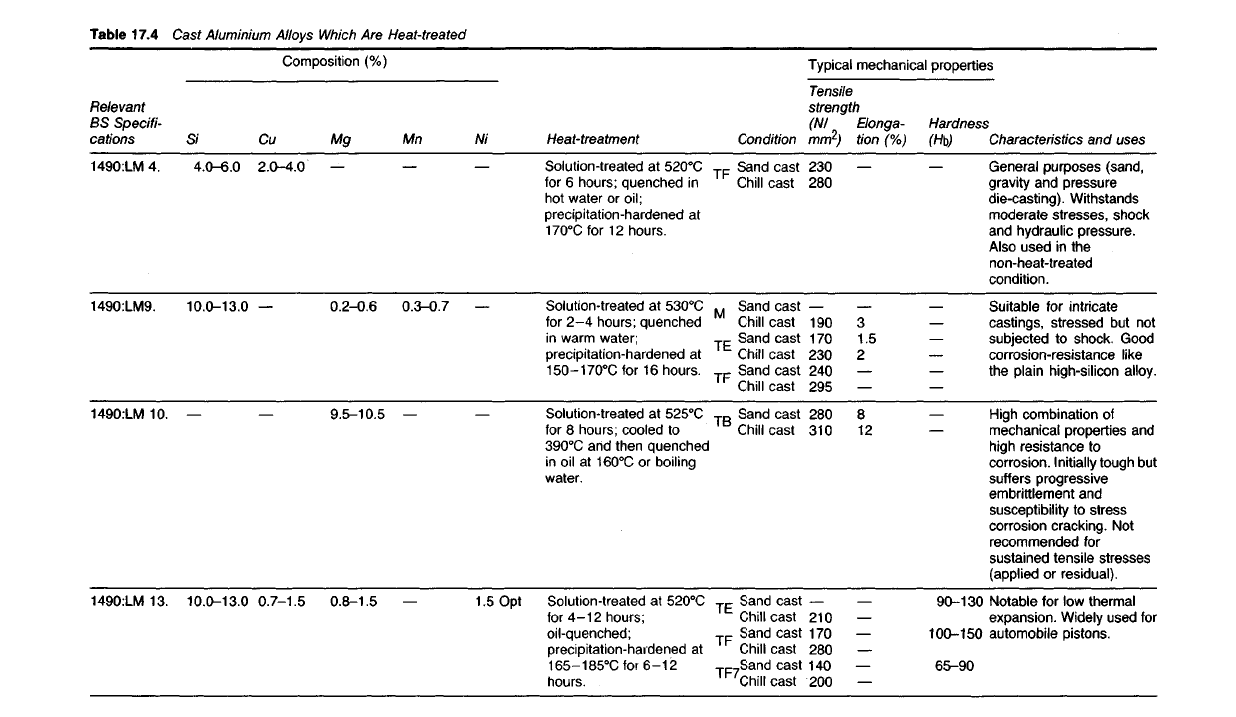
Table
17.4
Cast
Aluminium
Alloys
Which
Are
Heat-treated
Typical mechanical properties
Tensile
strength
Hardness
Characteristics
and
uses
General purposes (sand,
gravity
and
pressure
die-casting). Withstands
moderate stresses, shock
and hydraulic pressure.
Also
used
in the
non-heat-treated
condition.
Suitable
for
intricate
castings, stressed
but not
subjected
to
shock. Good
corrosion-resistance
like
the
plain
high-silicon
alloy.
High combination
of
mechanical properties
and
high
resistance
to
corrosion.
Initially
tough
but
suffers
progressive
embrittlement
and
susceptibility
to
stress
corrosion cracking.
Not
recommended
for
sustained
tensile
stresses
(applied
or
residual).
Notable
for low
thermal
expansion.
Widely used
for
automobile
pistons.
(HbJ
90-130
100-150
65-90
Elonga-
tion
(
0
A)
3
1.5
2
8
12
(NI
mm?-)
230
280
190
170
230
240
295
280
310
210
170
280
140
200
Condition
TF
Sand cast
Chill cast
M
Sand cast
Chill cast
TF
Sand cast
Chill
cast
TF
Sand cast
1
h
Chill cast
TR
Sand cast
Chill cast
TF
Sand cast
Chill
cast
TF
Sand cast
Chill cast
TF
Sand cast
Chill
cast
Heat-treatment
Solution-treated
at
520
0
C
for
6
hours; quenched
in
hot
water
or oil;
precipitation-hardened
at
170
0
C
for 12
hours.
Solution-treated
at
530
0
C
for
2-4
hours; quenched
in
warm water;
precipitation-hardened
at
150-170
0
C
for 16
hours.
Solution-treated
at
525°C
for
8
hours; cooled
to
390
0
C
and
then quenched
in
oil at
160
0
C
or
boiling
water.
Solution-treated
at
520
0
C
for
4-12
hours;
oil-quenched;
precipitation-hardened
at
165-185°Cfor
6-12
hours.
Composition
(%)
Ni
1.5
Opt
Mn
0.3-0.7
Mg
0.2-0.6
9.5-10.5
0.8-1.5
Cu
2.0-4.0
0.7-1.5
S/
4.0-6.0
10.0-13.0
10.0-13.0
Relevant
BS
Specifi-
cations
1490:LM
4.
1490:LM9.
14901M
10.
1490.LM
13.
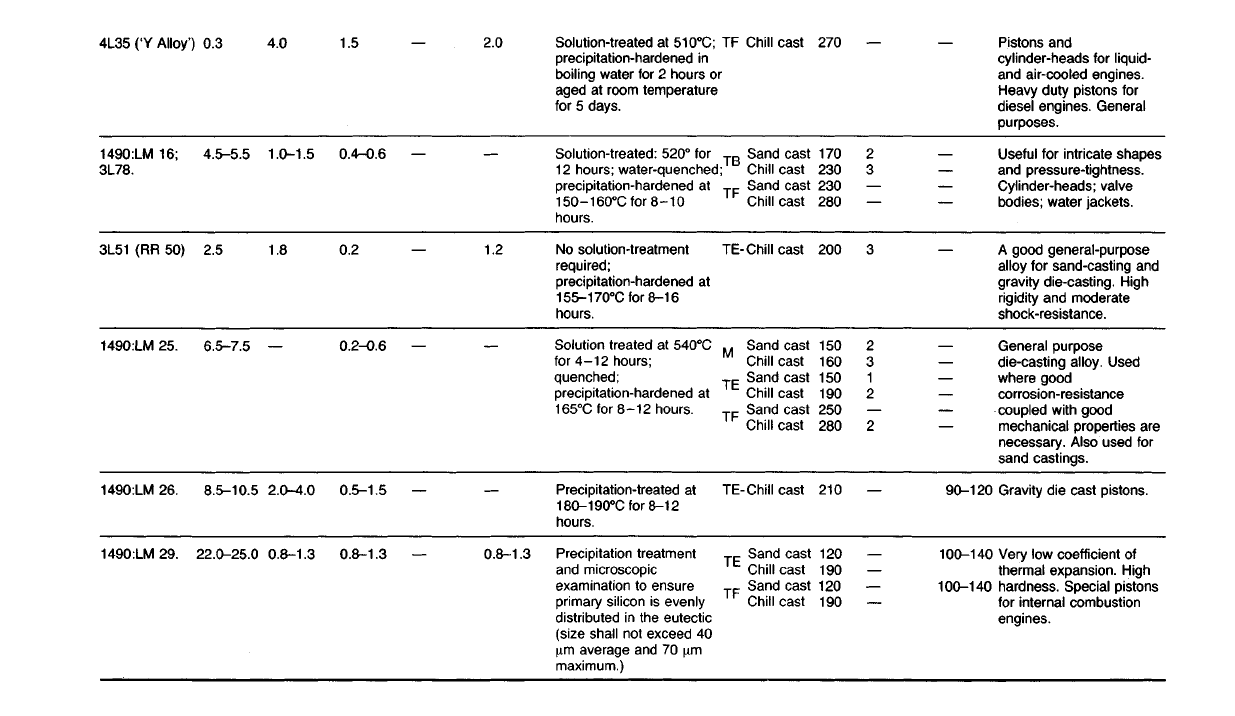
Pistons
and
cylinder-heads for liquid-
and air-cooled engines.
Heavy duty pistons for
diesel
engines.
General
purposes.
Useful
for
intricate shapes
and pressure-tightness.
Cylinder-heads; valve
bodies; water jackets.
A
good general-purpose
alloy
for
sand-casting
and
gravity
die-casting. High
rigidity
and
moderate
shock-resistance.
General purpose
die-casting alloy. Used
where good
corrosion-resistance
coupled with good
mechanical properties
are
necessary. Also used
for
sand castings.
Gravity
die
cast pistons.
Very
low
coefficient
of
thermal expansion. High
hardness. Special pistons
for
internal combustion
engines.
90-120
100-140
100-140
2
3
3
2
3
1
2
2
TF Chill cast
270
TR
Sand cast
170
Chill cast
230
TF
Sand cast
230
1
Chill cast
280
TE-Chill
cast
200
M
Sand
cast
150
Chill
cast
160
TF
Sand cast
150
Chill
cast
190
TF
Sand cast
250
Chill
cast
280
TE-Chill
cast
210
TF
Sand cast
120
1
Chill cast
190
TF
Sand cast
120
Chill
cast
190
Solution-treated
at
510
0
C;
precipitation-hardened
in
boiling water for
2
hours
or
aged
at
room temperature
for
5
days.
Solution-treated:
520°
for
12
hours; water-quenched;
precipitation-hardened
at
150-160
0
C
for
8-10
hours.
No solution-treatment
required;
precipitation-hardened
at
155-170
0
C
for
8-16
hours.
Solution treated
at
540
0
C
for
4-12
hours;
quenched;
precipitation-hardened
at
165°C
for
8-12
hours.
Precipitation-treated
at
180-190
0
C
for
8-12
hours.
Precipitation
treatment
and microscopic
examination
to
ensure
primary
silicon
is
evenly
distributed
in the
eutectic
(size shall not exceed
40
\im
average
and 70 |im
maximum.)
2.0
1.2
0.8-1.3
1.5
0.4^-0.6
0.2
0.2-0.6
0.5-1.5
0.8-1.3
4.0
1.0-1.5
1.8
2.0-4.0
0.8-1.3
0.3
4L35
('Y
Alloy')
4.5-5.5
2.5
6.5-7.5
8.5-10.5
22.0-25.0
1490:LM
16;
3L78.
3L51
(RR 50)
1490:LM
25.
1490:LM
26.
1490:LM
29.
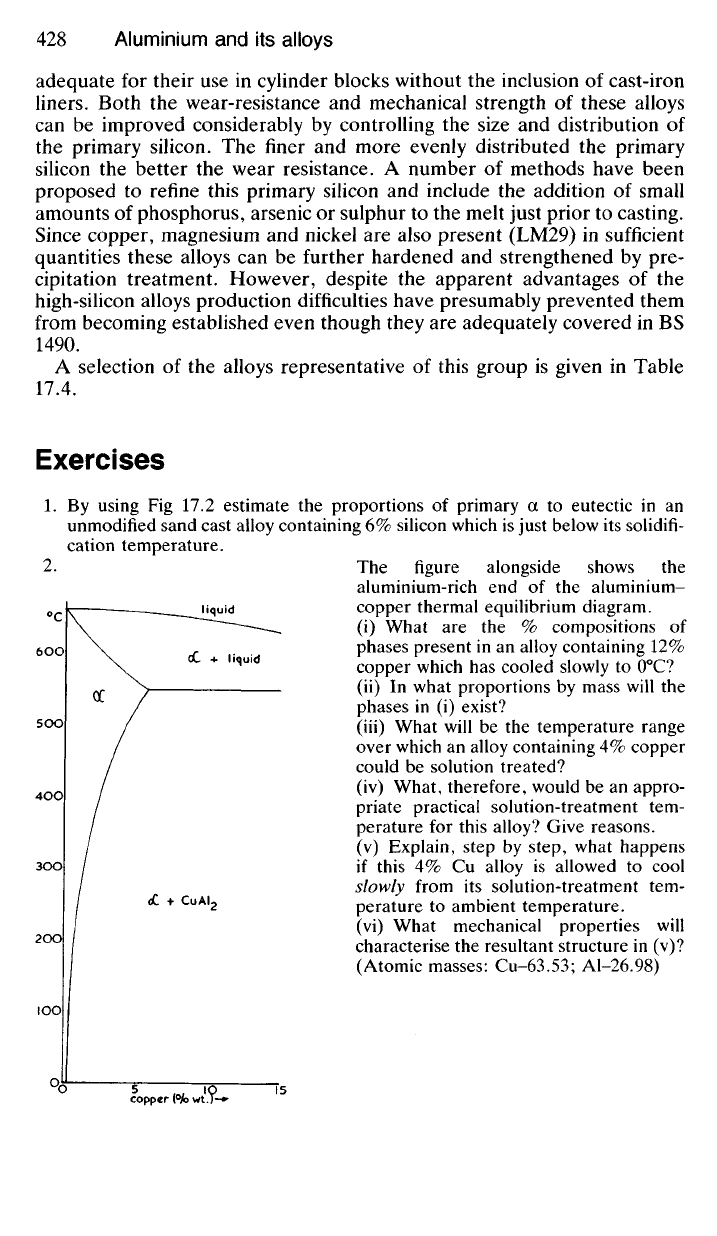
adequate for their use in cylinder blocks without the inclusion of cast-iron
liners.
Both the wear-resistance and mechanical strength of these alloys
can be improved considerably by controlling the size and distribution of
the primary silicon. The finer and more evenly distributed the primary
silicon the better the wear resistance. A number of methods have been
proposed to refine this primary silicon and include the addition of small
amounts of phosphorus, arsenic or sulphur to the melt just prior to casting.
Since copper, magnesium and nickel are also present (LM29) in sufficient
quantities these alloys can be further hardened and strengthened by pre-
cipitation treatment. However, despite the apparent advantages of the
high-silicon alloys production difficulties have presumably prevented them
from becoming established even though they are adequately covered in BS
1490.
A selection of the alloys representative of this group is given in Table
17.4.
Exercises
1.
By using Fig 17.2 estimate the proportions of primary a to eutectic in an
unmodified sand cast alloy containing 6% silicon which is just below its solidifi-
cation temperature.
2.
The figure alongside shows the
aluminium-rich end of the aluminium-
copper thermal equilibrium diagram.
(i) What are the % compositions of
phases present in an alloy containing 12%
copper which has cooled slowly to 0
0
C?
(ii) In what proportions by mass will the
phases in (i) exist?
(iii) What will be the temperature range
over which an alloy containing 4% copper
could be solution treated?
(iv) What, therefore, would be an appro-
priate practical solution-treatment tem-
perature for this alloy? Give reasons,
(v) Explain, step by step, what happens
if this 4% Cu alloy is allowed to cool
slowly from its solution-treatment tem-
perature to ambient temperature,
(vi) What mechanical properties will
characterise the resultant structure in (v)?
(Atomic masses: Cu-63.53; Al-26.98)
liquid
0
C
OC 4- liquid
copper
I
0
Ao
wt J
<£ + CuAI
2
QC
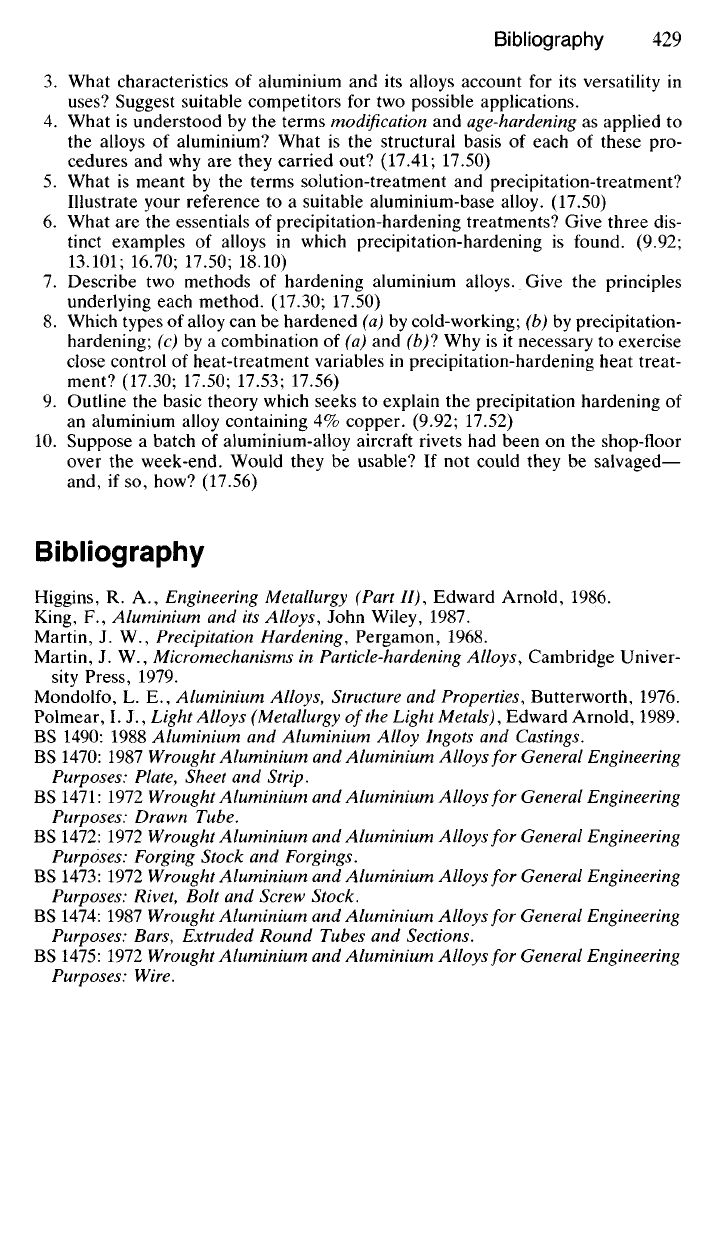
3.
What characteristics of aluminium and its alloys account for its versatility in
uses? Suggest suitable competitors for two possible applications.
4.
What is understood by the terms modification and
age-hardening
as applied to
the alloys of aluminium? What is the structural basis of each of these pro-
cedures and why are they carried out?
(17.41;
17.50)
5.
What is meant by the terms solution-treatment and precipitation-treatment?
Illustrate your reference to a suitable aluminium-base alloy. (17.50)
6. What are the essentials of precipitation-hardening treatments? Give three dis-
tinct examples of alloys in which precipitation-hardening is found. (9.92;
13.101;
16.70; 17.50; 18.10)
7.
Describe two methods of hardening aluminium alloys. Give the principles
underlying each method. (17.30; 17.50)
8. Which types of alloy can be hardened (a) by cold-working; (b) by precipitation-
hardening; (c) by a combination of (a) and (b)l Why is it necessary to exercise
close control of heat-treatment variables in precipitation-hardening heat treat-
ment? (17.30; 17.50;
17.53;
17.56)
9. Outline the basic theory which seeks to explain the precipitation hardening of
an aluminium alloy containing 4% copper. (9.92; 17.52)
10.
Suppose a batch of aluminium-alloy aircraft rivets had been on the shop-floor
over the week-end. Would they be usable? If not could they be salvaged—
and, if so, how? (17.56)
Bibliography
Higgins, R. A., Engineering Metallurgy (Part II), Edward Arnold, 1986.
King, F., Aluminium and its Alloys, John Wiley, 1987.
Martin, J. W.,
Precipitation
Hardening, Pergamon, 1968.
Martin, J. W., Micromechanisms in P
article-hardening
Alloys, Cambridge Univer-
sity Press, 1979.
Mondolfo, L. E., Aluminium Alloys, Structure and
Properties,
Butterworth, 1976.
Polmear, I. J., Light Alloys
(Metallurgy
of the Light Metals), Edward Arnold, 1989.
BS 1490: 1988 Aluminium and Aluminium Alloy Ingots and Castings.
BS 1470: 1987 Wrought Aluminium and Aluminium Alloys for General
Engineering
Purposes: Plate, Sheet and Strip.
BS 1471: 1972 Wrought Aluminium and Aluminium Alloys for General
Engineering
Purposes: Drawn Tube.
BS 1472: 1972 Wrought Aluminium and Aluminium Alloys for General
Engineering
Purposes: Forging Stock and Forgings.
BS 1473: 1972 Wrought Aluminium and Aluminium Alloys for General
Engineering
Purposes: Rivet, Bolt and Screw Stock.
BS 1474: 1987 Wrought Aluminium and Aluminium Alloys for General
Engineering
Purposes: Bars, Extruded Round Tubes and Sections.
BS 1475: 1972 Wrought Aluminium and Aluminium Alloys for General
Engineering
Purposes: Wire.
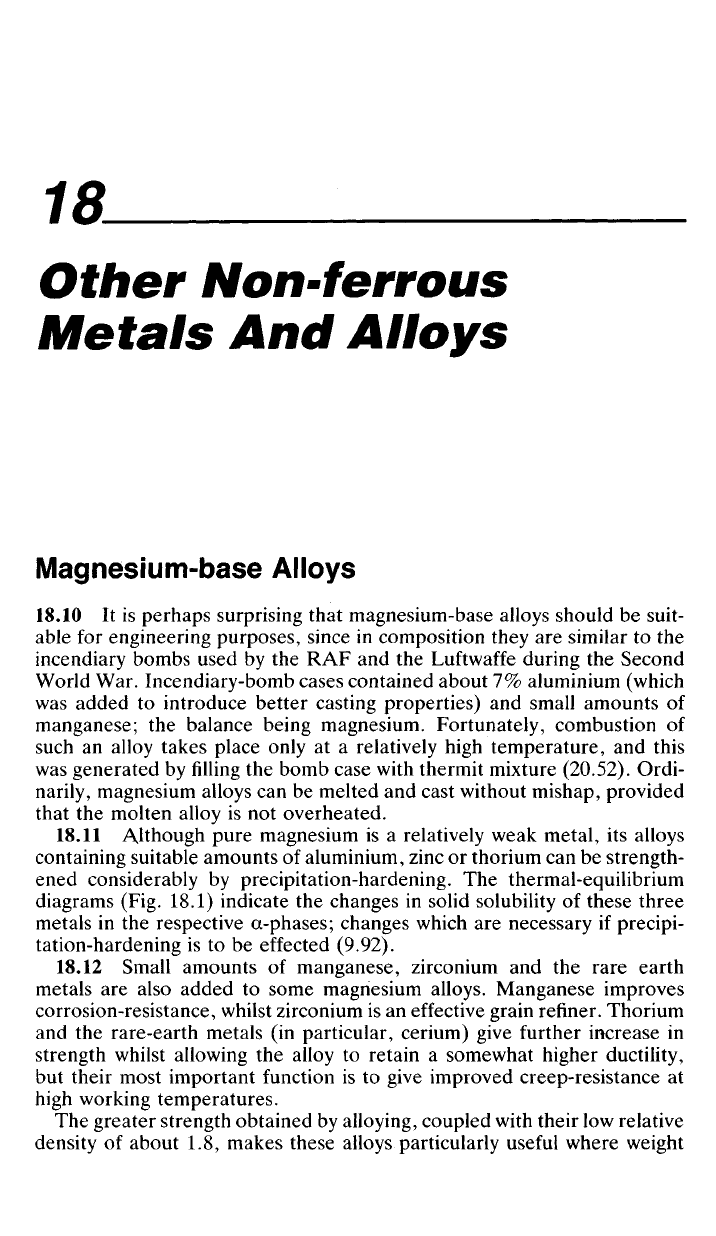
Other Non-ferrous
Metals And Alloys
Magnesium-base Alloys
18.10 It is perhaps surprising that magnesium-base alloys should be suit-
able for engineering purposes, since in composition they are similar to the
incendiary bombs used by the RAF and the Luftwaffe during the Second
World War. Incendiary-bomb cases contained about 7% aluminium (which
was added to introduce better casting properties) and small amounts of
manganese; the balance being magnesium. Fortunately, combustion of
such an alloy takes place only at a relatively high temperature, and this
was generated by filling the bomb case with thermit mixture (20.52). Ordi-
narily, magnesium alloys can be melted and cast without mishap, provided
that the molten alloy is not overheated.
18.11 Although pure magnesium is a relatively weak metal, its alloys
containing suitable amounts of aluminium, zinc or thorium can be strength-
ened considerably by precipitation-hardening. The thermal-equilibrium
diagrams (Fig. 18.1) indicate the changes in solid solubility of these three
metals in the respective a-phases; changes which are necessary if precipi-
tation-hardening is to be effected (9.92).
18.12 Small amounts of manganese, zirconium and the rare earth
metals are also added to some magnesium alloys. Manganese improves
corrosion-resistance, whilst zirconium is an effective grain refiner. Thorium
and the rare-earth metals (in particular, cerium) give further increase in
strength whilst allowing the alloy to retain a somewhat higher ductility,
but their most important function is to give improved creep-resistance at
high working temperatures.
The greater strength obtained by alloying, coupled with their low relative
density of about 1.8, makes these alloys particularly useful where weight
18
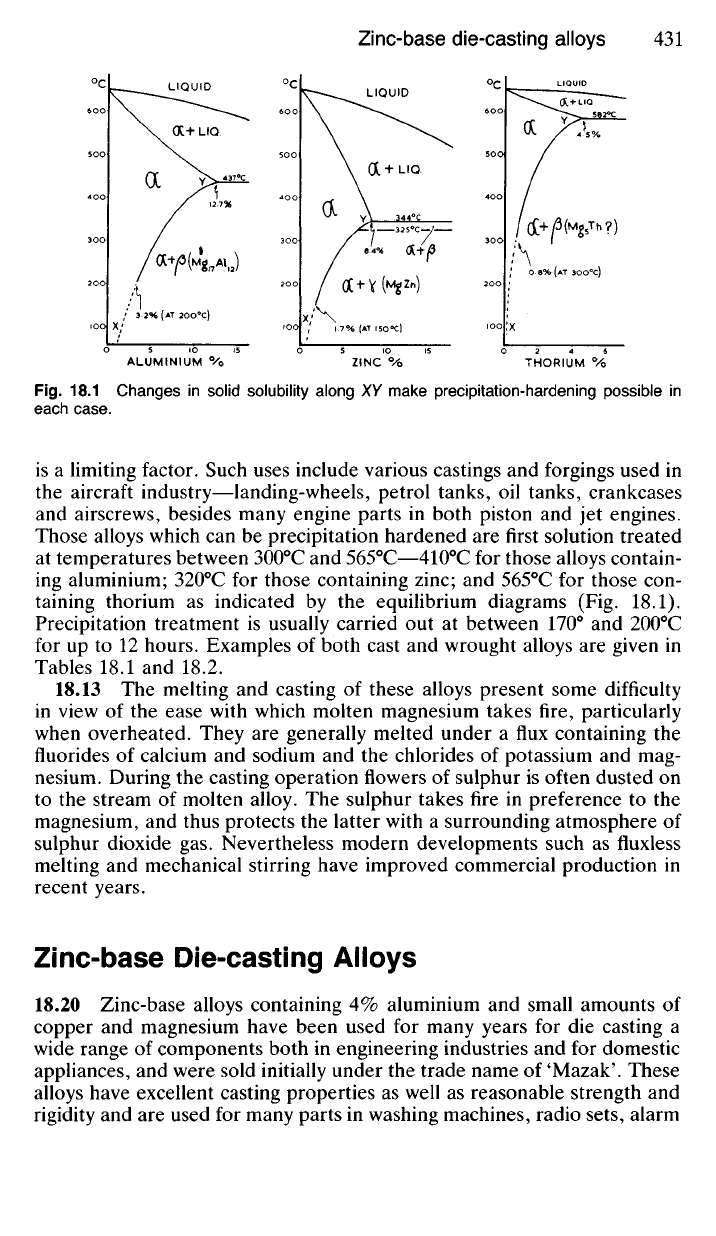
Fig.
18.1 Changes in solid solubility along XY make precipitation-hardening possible in
each case.
is a limiting factor. Such uses include various castings and forgings used in
the aircraft industry—landing-wheels, petrol tanks, oil tanks, crankcases
and airscrews, besides many engine parts in both piston and jet engines.
Those alloys which can be precipitation hardened are first solution treated
at temperatures between 300
0
C and 565°C—410
0
C for those alloys contain-
ing aluminium; 320
0
C for those containing zinc; and 565°C for those con-
taining thorium as indicated by the equilibrium diagrams (Fig. 18.1).
Precipitation treatment is usually carried out at between 170° and 200
0
C
for up to 12 hours. Examples of both cast and wrought alloys are given in
Tables 18.1 and 18.2.
18.13 The melting and casting of these alloys present some difficulty
in view of the ease with which molten magnesium takes fire, particularly
when overheated. They are generally melted under a flux containing the
fluorides of calcium and sodium and the chlorides of potassium and mag-
nesium. During the casting operation flowers of sulphur is often dusted on
to the stream of molten alloy. The sulphur takes fire in preference to the
magnesium, and thus protects the latter with a surrounding atmosphere of
sulphur dioxide gas. Nevertheless modern developments such as fluxless
melting and mechanical stirring have improved commercial production in
recent years.
Zinc-base Die-casting Alloys
18.20 Zinc-base alloys containing 4% aluminium and small amounts of
copper and magnesium have been used for many years for die casting a
wide range of components both in engineering industries and for domestic
appliances, and were sold initially under the trade name of 'Mazak'. These
alloys have excellent casting properties as well as reasonable strength and
rigidity and are used for many parts in washing machines, radio sets, alarm
°c
LIQUID
LIQUID
0
C
0
C
LIQUID
ALUMINIUM %
ZINC °/o
THORIUM %
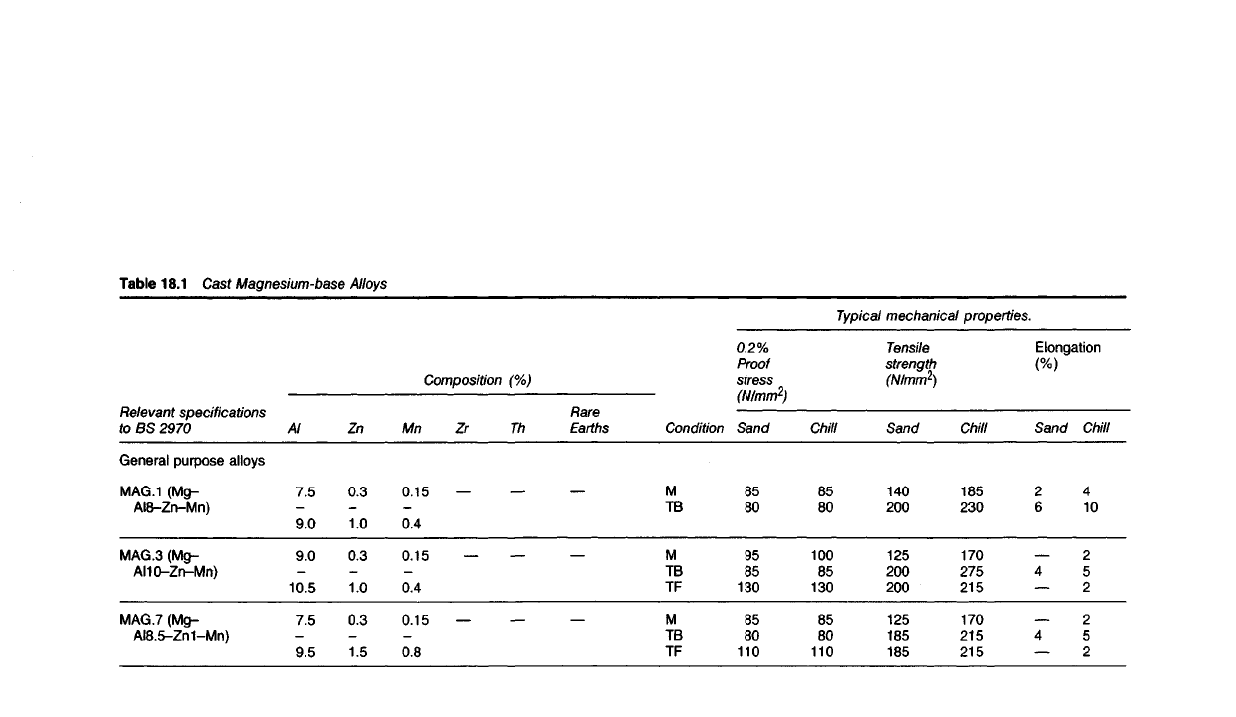
Table
18.1
Cast Magnesium-base Alloys
Typical
mechanical properties.
Elongation
(%)
Chill
4
10
2
5
2
2
5
2
Sand
2
6
4
4
Chill
185
230
170
275
215
170
215
215
Tensile
strength
(N/mm
2
)
Sand
140
200
125
200
200
125
185
185
Chill
85
80
100
85
130
85
80
110
0.2%
Proof
stress
(N/mm
2
)
Sand
85
80
95
85
130
85
80
110
Condition
M
TB
M
TB
TF
M
TB
TF
Rare
Earths
Composition
(%)
Th
Zr
Mn
0.15
0.4
0.15
0.4
0.15
0.8
Zn
0.3
1.0
0.3
1.0
0.3
1.5
Al
7.5
9.0
9.0
10.5
7.5
9.5
Relevant
specifications
to
BS
2970
General purpose alloys
MAG.1
(Mgr-
AI8-Zn-Mn)
MAG.3
(Mg-
AIIO-Zn-Mrr)
MAG.7
(Mg-
AI8.5-Zn1-Mn)
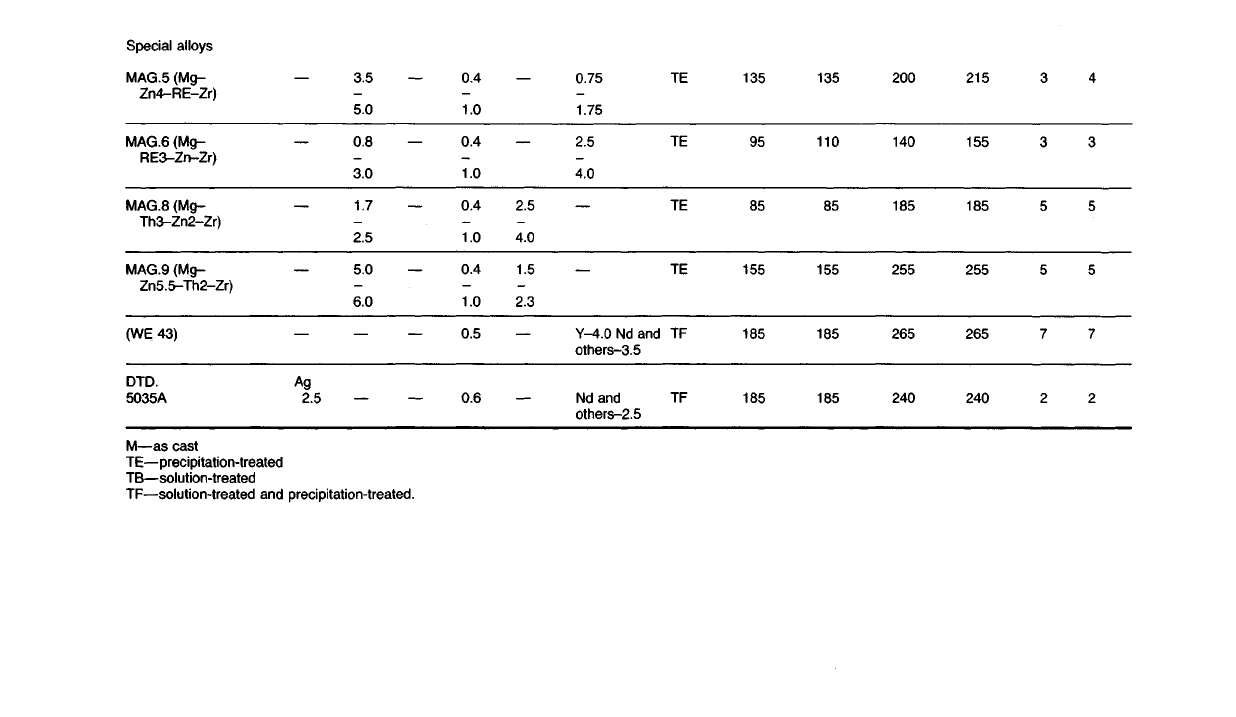
4
3
5
5
7
2
3
3
5
5
7
2
215
155
185
255
265
240
200
140
185
255
265
240
135
110
85
155
185
185
135
95
85
155
185
185
TE
TE
TE
TE
TF
TF
0.75
1.75
2.5
4.0
Y-4.0 Nd and
others-3.5
Nd
and
others-2.5
2.5
4.0
1.5
2.3
0.4
1.0
0.4
1.0
0.4
1.0
0.4
1.0
0.5
0.6
3.5
5.0
0.8
3.0
1.7
2.5
5.0
6.0
Ag
2.5
Special
alloys
MAG.5
(Mg-
Zn4-RE-Zr)
MAG.6
(Mg-
RE3-Zn-Zr)
MAG.8
(Mg-
Th3-Zn2-Zr)
MAG.9
(Mg-
Zn5.5-Th2-Zr)
(WE
43)
DTD.
5035A
M—as
cast
TE—precipitation-treated
TB—solution-treated
TF—solution-treated
and
precipitation-treated.
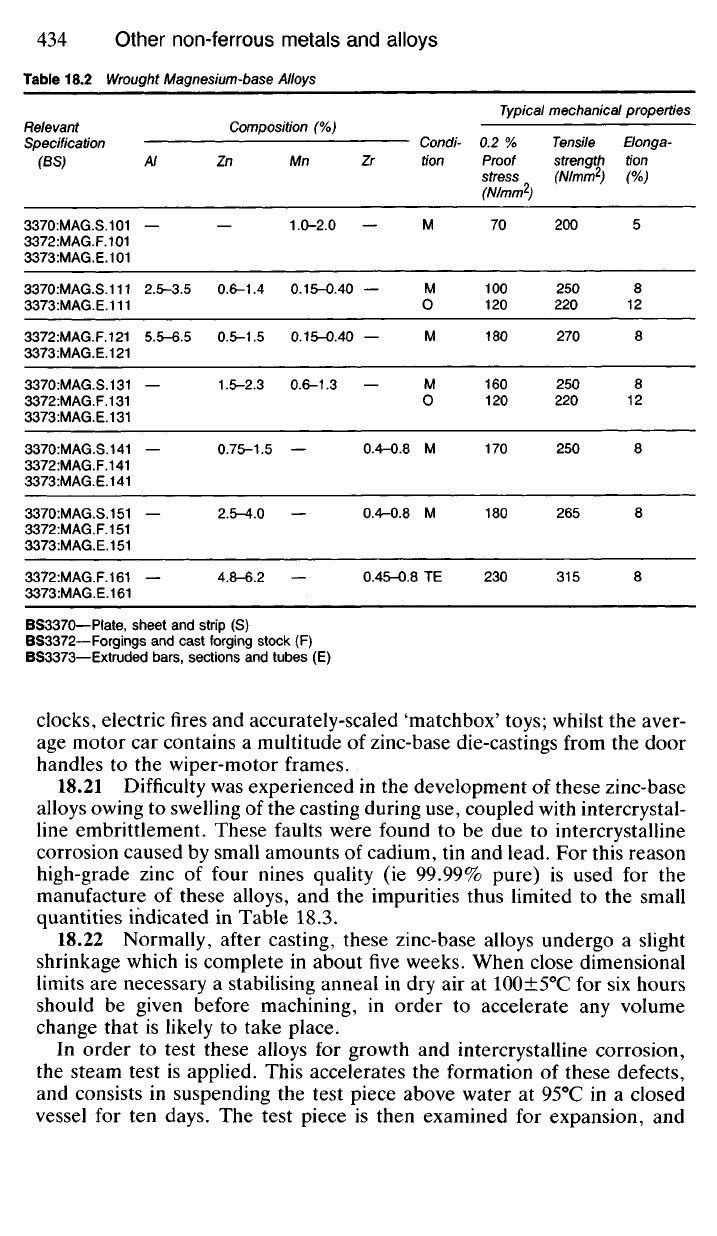
Table
18.2
Wrought Magnesium-base Alloys
Relevant
Specification
(BS)
337O:MAG.S.1O1
3372.MAG.F.101
3373:MAG.E.1O1
3370.MAG.S.111
3373:MAG.E.111
3372.MAG.F.121
3373:MAG.E.121
3370:MAG.S.131
3372.MAG.F.131
3373:MAG.E.131
3370:MAG.S.141
3372:MAG.F.141
3373:MAG.E.141
3370:MAG.S.151
3372:MAG.F.151
3373:MAG.E.151
3372:MAG.F.161
3373:MAG.E.161
Composition
(%)
Al
2.5-3.5
5.5-6.5
Zn
0.6-1.4
0.5-1.5
1.5-2.3
0.75-1.5
2.5-4.0
4.8-6.2
Mn
1.0-2.0
0.15-0.40
0.15-0.40
0.6-1.3
Zr
0.4-0.8
0.4-0.8
0.45-0.8
Condi-
tion
M
M
O
M
M
O
M
M
TE
Typical mechanical properties
0.2
%
Proof
stress
(N/mm
2
)
70
100
120
180
160
120
170
180
230
Tensile
strength
(N/mm
2
)
200
250
220
270
250
220
250
265
315
Elonga-
tion
(%)
5
8
12
8
8
12
8
8
8
BS3370—Plate, sheet and strip
(S)
BS3372—Forgings and cast forging stock
(F)
BS3373—Extruded bars, sections and tubes
(E)
clocks, electric fires
and
accurately-scaled 'matchbox' toys; whilst
the
aver-
age motor
car
contains
a
multitude
of
zinc-base die-castings from
the
door
handles
to the
wiper-motor frames.
18.21 Difficulty was experienced
in the
development
of
these zinc-base
alloys owing
to
swelling
of
the casting during use, coupled with intercrystal-
line embrittlement. These faults were found
to be due to
intercrystalline
corrosion caused
by
small amounts
of
cadium,
tin and
lead.
For
this reason
high-grade zinc
of
four nines quality
(ie
99.99% pure)
is
used
for the
manufacture
of
these alloys,
and the
impurities thus limited
to the
small
quantities indicated
in
Table 18.3.
18.22 Normally, after casting, these zinc-base alloys undergo
a
slight
shrinkage which
is
complete
in
about five weeks. When close dimensional
limits
are
necessary
a
stabilising anneal
in dry air at
100±5°C
for six
hours
should
be
given before machining,
in
order
to
accelerate
any
volume
change that
is
likely
to
take place.
In order
to
test these alloys
for
growth
and
intercrystalline corrosion,
the steam test
is
applied. This accelerates
the
formation
of
these defects,
and consists
in
suspending
the
test piece above water
at
95°C
in a
closed
vessel
for ten
days.
The
test piece
is
then examined
for
expansion,
and
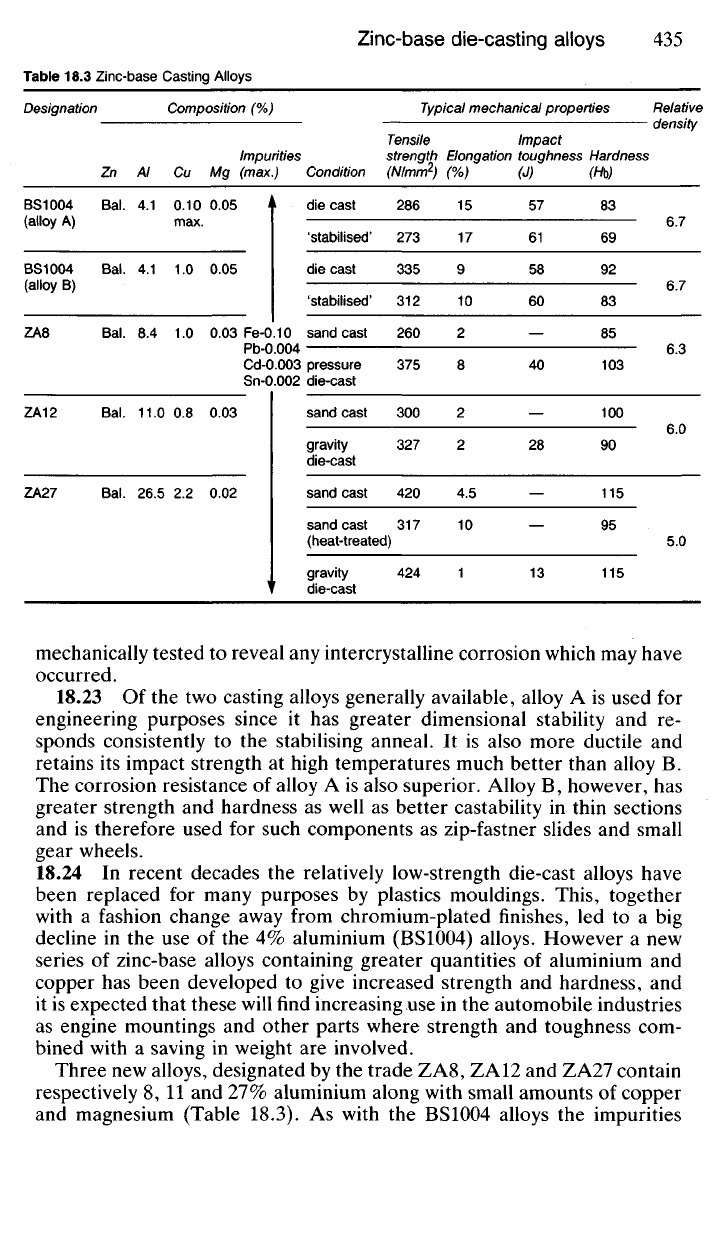
mechanically tested to reveal any intercrystalline corrosion which may have
occurred.
18.23 Of the two casting alloys generally available, alloy A is used for
engineering purposes since it has greater dimensional stability and re-
sponds consistently to the stabilising anneal. It is also more ductile and
retains its impact strength at high temperatures much better than alloy B.
The corrosion resistance of alloy A is also superior. Alloy B, however, has
greater strength and hardness as well as better castability in thin sections
and is therefore used for such components as zip-fastner slides and small
gear wheels.
18.24 In recent decades the relatively low-strength die-cast alloys have
been replaced for many purposes by plastics mouldings. This, together
with a fashion change away from chromium-plated finishes, led to a big
decline in the use of the 4% aluminium (BS1004) alloys. However a new
series of zinc-base alloys containing greater quantities of aluminium and
copper has been developed to give increased strength and hardness, and
it is expected that these will find increasing use in the automobile industries
as engine mountings and other parts where strength and toughness com-
bined with a saving in weight are involved.
Three new alloys, designated by the trade ZA8, ZA12 and ZA27 contain
respectively 8, 11 and 27% aluminium along with small amounts of copper
and magnesium (Table 18.3). As with the BS1004 alloys the impurities
Table 18.3 Zinc-base Casting Alloys
Designation
BS1004
(alloy A)
BS1004
(alloy B)
ZA8
ZA12
ZA27
Composition
(%)
Zn
BaI.
BaI.
BaI.
BaI.
BaI.
Al
4.1
4.1
8.4
11.0
26.5
Cu
0.10
max.
1.0
1.0
0.8
2.2
Mg
0.05
0.05
0.03
0.03
0.02
Impurities
(max.)
Fe-0.10
Pb-0.004
Cd-0.003
Sn-0.002
Condition
die cast
'stabilised'
die cast
'stabilised'
sand cast
pressure
die-cast
sand cast
gravity
die-cast
sand cast
Typical
mechanical
properties
Tensile
strength
(N/mm
2
)
286
273
335
312
260
375
300
327
420
sand cast
(heat-treated)
gravity
die-cast
317
424
Elongation
(%)
15
17
9
10
2
8
2
2
4.5
10
1
Impact
toughness
(J)
57
61
58
60
40
28
13
Hardness
(Hb)
83
69
92
83
85
103
100
90
115
95
115
Relative
density
6.7
6.7
6.3
6.0
5.0
